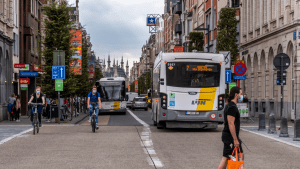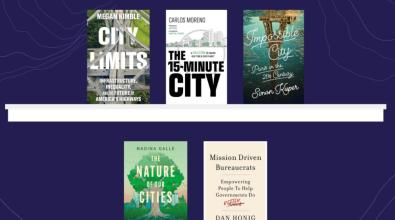Why the EU’s ‘innovation capital’ is a model for cities worldwide

Some people know Leuven, a Belgium city of 100,000 not far from Brussels, for its beer: It’s home to both Stella Artois and the world’s largest brewer, AB InBev. Others know it for KU Leuven, one of Europe’s oldest and most prestigious research universities. Now, city leaders around the world are coming to know Leuven for something new: It’s just been named the European Union’s “Capital of Innovation.”
The European Commission, which bestowed the honor last month, recognized Leuven for the creative and systematic ways the city engages residents in decision making, particularly with experiments around reducing greenhouse-gas emissions. That effort, known as Leuven 2030, is itself an innovative governance model, engaging a cross-sector group of more than 600 partners in what Mayor Mohamed Ridouani calls a “radical participation approach.”
To learn more, Bloomberg Cities caught up with Mayor Ridouani. Elected in 2018, Ridouani is himself a graduate of KU Leuven who worked as a business consultant before going into local politics. For 12 years before he became mayor, Ridouani served as Deputy Mayor for Education, Sustainability, Urban Development and Economy, where he launched the Leuven 2030 initiative.
Bloomberg Cities: Congratulations on Leuven being named Europe’s “innovation capital.” What does it say about the city’s approach?
Mayor Mohamed Ridouani: We want to be Europe’s “future lab,” where solutions take place first. Solutions in terms of climate change, poverty, disease — Leuven is one place where research is being done for a COVID-19 vaccine. But we want to do it in an inclusive way. We want solutions that work for all. That’s a baseline, a motto, and the way we operate.
How is that embodied in Leuven 2030?
A lot of cities are experimenting with participation and how to include citizens to get their buy-in. We’ve done it in a very structural and systemic way. We’ve built this collaboration between what we call the “quadruple helix,” which includes all the layers of society: government, knowledge institutions, companies, and citizens.
For climate change, we said, “Look, Leuven and its partners are not doing a bad job in terms of finding new solutions for mobility, energy, et cetera.” But it was not enough. It was not leading. So we thought about inclusive innovation and came up with an organizational structure with a legal framework around it. That’s where we established Leuven 2030. It’s a radical participation approach with a new governance model where every layer of society has an equal stake.
Anybody can become a member of Leuven 2030 and be represented in its General Assembly. City government gets 20 percent of the votes, companies get 20 percent, knowledge institutions like universities and research centers get 20 percent, then citizens and NGOs have 20 percent, and then there’s 20 percent for semi-public institutions like our public transport company and energy companies. I had to convince my city council to give away powers and influence about climate policy to that organization, and the other members had to do the same thing. We had to go in with a new logic of collaboration and of sharing responsibility and power within that organization.
All these members resource the organization with money and personnel. They adopt projects and experiments — at the moment we have 180 experiments going — where we put researchers together with creative people, with citizens, with entrepreneurs and investors, and they find solutions.
Can you give an example?
We are an ancient city with a lot of historic buildings. To keep them warm, you cannot just put some insulation against the wall. You need to find new solutions to warm up these buildings without using fossil fuel. That’s one of the experiments — where we put together all these bright people and they came up with solutions like using groundwater for heat, without touching the historical value of the building. When they come up with a solution that works, the partners will adopt it.
How is accountability maintained?
The partners have to show each year the results of what they are doing, and how they contribute to the mission of Leuven 2030. Each year, there is an evaluation. If you don’t meet the standards, you have to adapt or get out.
In the beginning, there was some hesitation, because you need to build trust. At the same table you had the green NGOs who want to go really fast and are sometimes looking at the companies and the government like, “Hey, you’re not on my side.” And then there are some companies and entrepreneurs who said, “I want to see what the return on investment is.”
That’s why we have this horizontal coalition. It’s a power-sharing system with equal representation, and we are all in this together. We all want the city to be climate-neutral — so no CO2 emissions — and to have a livable environment for all with a high quality of life. And as we started to see the wins from what we were doing, this became a community approach.
For example, we’ve totally changed the mobility plan in the city, pushing out the cars from our city center. It’s now almost car-free. It was a heavy debate, but because it came out of Leuven 2030, there already was big buy-in. Today, as a result of that, biking has increased 40 percent in three years and we are the number one biking city in Belgium.
[Read: Athens wins prestigious European innovation prize for 2018]
Where does leadership come from within the organization?
The organization is led by a director, Katrien Rycken, who is an amazing strong leader. She is, let’s say, the spider in the web. The director, with her team, oversees all the action plans and communication. In the first years, I was the president of the organization. It’s a rotating presidency. And there is a board of directors, which gives direction. The funding comes 50 percent from the city and 50 percent from the other partners. And lately, they’ve been attracting funding from the European Commission, for example, to do big programs around mobility, buildings, and renewables.
One thing that is important is that in the organization, you not only have NGOs that are specialized with a mission around ecology, but you also have poverty-focused NGOs and grassroots groups that are doing neighborhood work. The city is providing funds so we can insulate social housing. So it’s not just the middle class and above that will benefit. It should be a social, just transition, as well.
What are some other examples of how Lueven engages residents in innovation?
For six months, we had a project where our citizens collected data using a smartphone app while they were cycling. It allowed us to see the most used routes and look at whether the infrastructure is adapted to that. We found that it was not in a lot of places. So we designed a new mobility plan based on that.
Another example is speed limits: We decided to make the entire city a zone of 30 kilometers an hour — about 18 miles per hour. Now that we have lowered the speed limit, they have this technology that you can put at your window to measure the speed of the cars. We want to see how people adapt to these new measures — what is the impact of the decisions we are making, and do we need to make changes?
Also, we have a canal area here, which used to belong to Stella Artois and all these old factories years ago. It’s been renovated into a very vibrant area with bars and cultural centers and a lot of creative people. Now we want to redesign the public space. We had a citizen jury of 12 people picked randomly from among 2,000 who applied to decide about the design and about which architectural firm to use. Their inputs made the decision making better. They gave feedback we hadn’t thought of.
When you are open as a mayor or as a government to include people, the buy-in is much bigger. People understand it better, because you confront them with the complexity of the decision-making and they see that these decisions are not binary. I want to invest more in that.
[Read: How Helsinki uses a board game to promote public participation]
How are you applying this mindset of collaboration and citizen engagement to COVID-19?
The COVID crisis was for me the stress test for our model of collaboration. Would that also work in a crisis situation? And it did. As a country, we are not doing well. The communication was not what it should be, there was a lot of confusion about what should be done, whether we should wear masks. But in Leuven, we immediately adopted a very proactive approach.
I imposed a local lockdown before the national one, after bringing together leaders from the clinics, university, police, safety. We talked about it and said, “Look, this is serious.” I remember the day, it was the 12th of March, and I thought, OK, fasten your seatbelts because a revolution might break out now. But people welcomed it. They said: “Finally, there’s leadership. Someone is deciding.” And the other partners said this is the right thing to do.
We were the first city to order and distribute all inhabitants masks, which are washable and reusable. We were the first to impose mask wearing in different public spaces where you have a lot of people. And we were the first to develop a platform to match people who wanted to volunteer with people who needed help. We always took the lead. We even did a communication campaign, which translates as “Apart for a while but together forever.” We printed posters and distributed them, and they are windows of homes all over the city.
You’ve been talking about collaboration in so many areas — climate, mobility, public health. Why does this matter?
I go back to human nature. In the last decades, we came to believe that we’re quite on our own in solving our issues. And that if you are successful, then you must be brilliant, and if you have failure, then it’s your fault. It’s survival of the fittest. That will not work. It doesn’t work in a crisis like COVID, where you see that you have to collaborate, and it doesn’t work in daily life.
I believe that we humans have survived for all these millenniums because it is in our nature to collaborate. We had to cope with natural disasters, or with animals that were bigger and stronger than us. The humans survived because of our ability to collaborate, not because of our ability to fight one another.
We need to get close to that human nature to solve the challenges of our time. That’s really my belief. At my local scale, I see good results solving problems when I bring people together who have diverse backgrounds in age, in gender, in ethnicity, but also in education and in talent. That crossover gets you better results. We can learn from each other and it will enrich us. And underneath that, there is a city that we are all responsible for and which we all should work on.
Photo courtesy of Tina Vander Molen/Shutterstock




